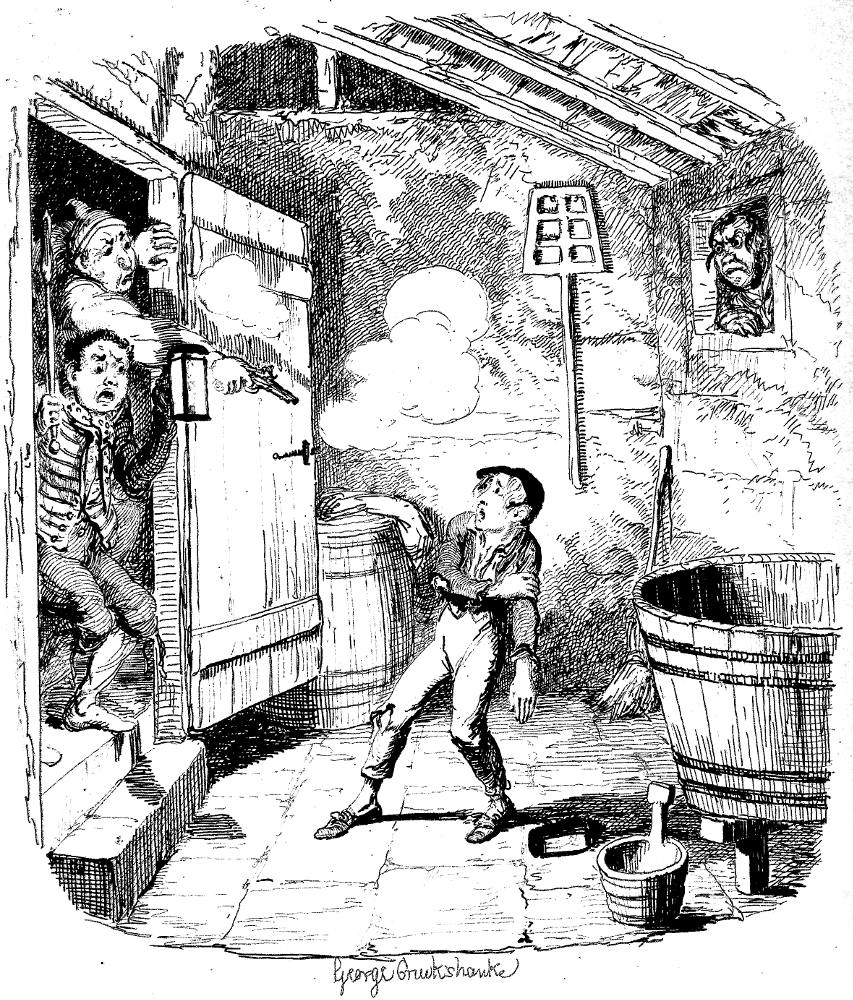
Sikes, with Oliver's hand still in his, softly approached the low porch — James Mahoney's twelfth illustration, intended to prepare readers of the Household Edition for Oliver's role in Bill Sikes and Toby Crackit's abortive robbery of the Maylie mansion at Chertsey in Surrey. In the original narrative-pictorial sequence by caricaturist George Cruikshank in Bentley's Miscellany, the serial reader encountered a realization of Oliver's being discovered by the servants shortly after climbing in through a diminutive window in the January 1838 illustration The Burglary at the Maylies' home in Chertsey. In the two Mahoney complementary scenes, however, as the illustrator attempts to intensify the suspense, we are still witnessing events leading up to the attempted robbery in Dickens's The Adventures of Oliver Twist, Household Edition, page 73. 1871. Wood engraving by the Dalziels, 9.4 cm high by 13 cm wide. In the Mahoney illustration, the burly figure of the Sikes (in his signature slightly battered white top-hat, centre) and his reluctant charge, Oliver in a cape, are approaching the back porch of a dilapidated house south of London, outside Shepperton, where the housebreaker is about to rendezvous with his confederates, Fagin's man, Barney, and Toby Crackit, who has already investigated the security of the house they intend to rob. Sikes's massive bulk and huge hand contrast the delicate frame and tiny hand of the boy, dramatizing the threat of reprisal under which Oliver is acting. Scanned image and text by Philip V. Allingham. [You may use this image without prior permission for any scholarly or educational purpose as long as you (1) credit the person who scanned the image and (2) link your document to this URL in a web document or cite it in a print one.]
Passage Illustrated
He [Oliver, believing that Sikes was about to drown him] was about to throw himself on the ground, and make one struggle for his young life, when he saw that they stood before a solitary house: all ruinous and decayed. There was a window on each side of the dilapidated entrance; and one story above; but no light was visible. The house was dark, dismantled: and the all appearance, uninhabited.
Sikes, with Oliver’s hand still in his, softly approached the low porch, and raised the latch. The door yielded to the pressure, and they passed in together.
[Chapter 21, "The Expedition," page 78]
Commentary
By sheer coincidence or through the machinations of Providence, the house in Chertsey that Sikes has selected as his target belongs to the Maylies, the wealthy family who adopted Rose, the sister of Agnes, Oliver's mother. Although Dickens's official illustrator for Oliver Twist, George Cruikshank depicts the housebreaker Bill S ikes as the sordid, lower-class villain out of contemporary melodrama, the figure whom Felix Octavius Carr Darley in his 1888 series of Character Sketches from Dickensdepicts seems to have been influenced by Mahoney's more realistic treatment, which in turn has influenced Harry Furniss's interpretation of the brutal housebreaker, who, after all, must possess a certain allure for his companion in crime, Nancy. He cannot logically be a mere Hogarthian ruffian, as in Cruikshank, or an evolutionary throwback, as in Eytinge.
In the monthly wrapper containing eleven scenes from the novel for the 1846 serialization, Cruikshank (rather than Dickens's usual illustrator of the 1840s, Hablot Knight Browne) includes in the design's upper left-hand corner Sikes at the window on the outside of the house, gesticulating as if telling Oliver how to open the door for Sikes himself, Nancy, and Toby Crackit once Oliver has descended to the floor; by its prominence in the wrapper, Cruikshank is implying that the incident is significant in Oliver's "progress." In the Household Edition, however, Mahoney focuses on two scenes immediately preceding the botched robbery, perhaps aware that his readers would inevitably compare his treatment of The Burglary to Cruikshank's The Burglary. Such a consideration, however, did not prevent fin de siecle illustrator Harry Furniss from attempting a much more dynamic composition in which the focus is the four servants who burst into the storeroom as Oliver is about to pass out. Seeing the picture before reading the accompanying text, one might expect the worst, but by the end of the closing curtain Sikes has at least abstracted Oliver from the immediate danger posed by the armed servants — who become four in number in the Furniss illustration. Mahoney, on the other hand, having set the scene with two introductory illustrations — the complement to the Shepperton scene being "Directly I leave go of you, do your work. Hark!"), leaves the narration of the most exciting part of the episode, Oliver's confronting the armed servants, entirely up to Dickens.
Relevant Illustrations from the Serial (1838) and the Charles Dickens Library Edition (1910)



Left: George Cruikshank's The Burglary (1838). Centre: Harry Furniss's Oliver in the Grip of Sikes (1910). Right: Harry Furniss's Bill Sikes (1910). [Click on images to enlarge them.]
References
Bentley, Nicolas, Michael Slater, and Nina Burgis. The Dickens Index. New York and Oxford: Oxford U. P., 1990.
Darley, Felix Octavius Carr. Character Sketches from Dickens. Philadelphia: Porter and Coates, 1888.
Davis, Paul. Charles Dickens A to Z: The Essential Reference to His Life and Work. New York: Facts On File, 1998.
Dickens, Charles. Oliver Twist. Illustrated by George Cruikshank. London: Bradbury and Evans; Chapman and Hall, 1846.
Dickens, Charles. Oliver Twist. Works of Charles Dickens. Household Edition. 55 vols. Il. F. O. C. Darley and John Gilbert. New York: Sheldon and Co., 1865.
Dickens, Charles. Oliver Twist. Works of Charles Dickens. Diamond Edition. 18 vols. Illustrated by Sol Eytinge, Jr. Boston: Ticknor and Fields, 1867.
Dickens, Charles. The Adventures of Oliver Twist. Works of Charles Dickens. Household Edition. Illustrated by James Mahoney. London: Chapman and Hall, 1871.
Dickens, Charles. Oliver Twist. Works of Charles Dickens. Charles Dickens Library Edition. Illustrated by Harry Furniss. London: Educational Book Company, 1910.
Last modified 7 December 2014